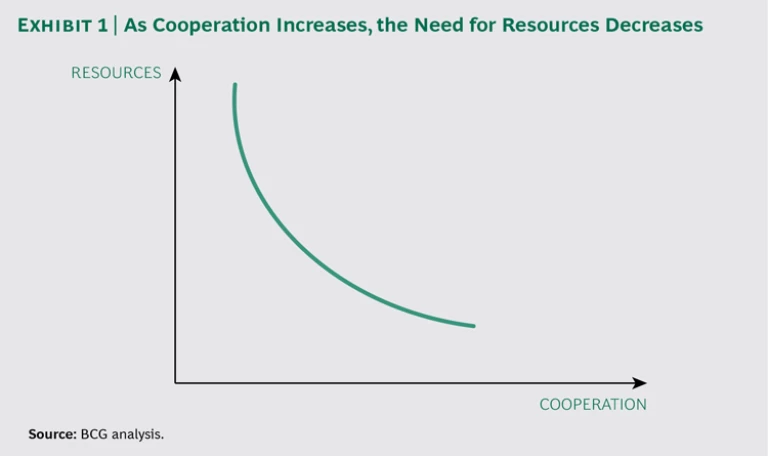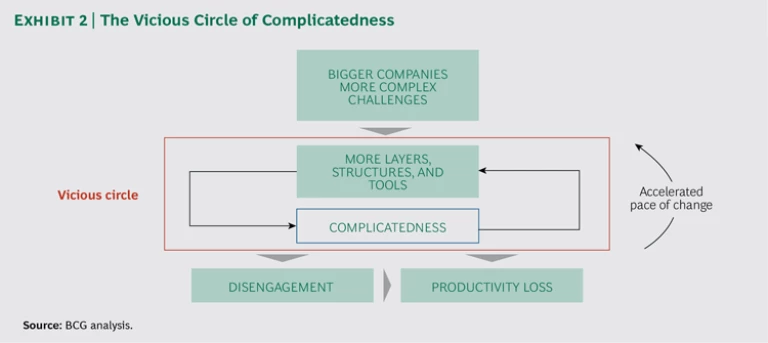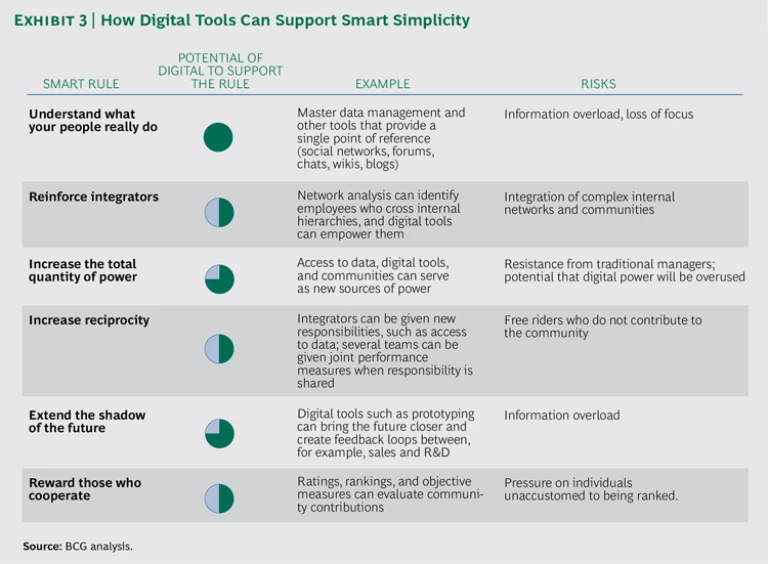Robert Solow, Nobel laureate in economics, famously quipped in 1987 that “you can see the computer age everywhere but in the productivity statistics.” Other than a brief bump between 1995 and 2000, the growth in productivity in advanced economies has not kept pace with the growth in IT spending.
Technology was supposed to free people for more productive uses of their time. But so far it has not worked out that way. Companies invested heavily in technology but not in true integration. They integrated the tools with one another but not with the way people work. As a result, they often made matters worse. The technology that was meant to liberate employees has insidiously trapped them. It is no wonder that, in 2014 in the US, 51% of employees reported being disengaged, while 18% said they were “actively disengaged,” a recipe for subtle forms of corporate sabotage.
Now we are at the dawn of a new technology age, characterized by the explosive growth of data, connectivity, and processing power. And while history might suggest that today’s digital, cloud, and connected technologies will have little effect on productivity, we believe their benefits could be substantial. Compared with the industrial systems of the past (massive HR, ERP, and CRM databases), today’s technology is more flexible, forgiving, and conducive to collaboration and data analytics. For example, agile software development, which is based on iteration and continual improvement, allows developers to write code that conforms to how people actually do their jobs.
If companies successfully marry these new digital approaches with what we call “smart simplicity,” they can unleash the latent power of their technology and their people. Smart simplicity is built on the premise that companies are most productive when they harness the intelligence of their employees. (See “ Smart Rules: Six Ways to Get People to Solve Problems Without You ,” BCG article, October 2011.) Many of today’s most successful digital natives, such as Netflix and Spotify, deploy aspects of smart simplicity in order to run agile and productive businesses.
Fixing Taylor’s Legacy
The structure of the modern corporation owes a debt to Frederick Taylor, a US mechanical engineer who applied the principles of his profession to factories. Taylor’s approach assumed that workers had little ability to think for themselves and work unsupervised. Today, 100 years after Taylor laid out his system of scientific management, the introduction of technology into organizations built on his principles tends to constrain rather than expand employees’ ability to exercise their creativity.
Smart simplicity seeks to unlock productivity by creating an environment in which employees are able to both exercise their autonomy and work together. Autonomy harnesses people’s flexibility and agility, while cooperation multiplies the effects of their efforts through synergy. When people cooperate, they require fewer resources. (See Exhibit 1.)
What’s more, smart simplicity and digital work well together. Digital technologies facilitate the autonomy and cooperation at the heart of smart simplicity, and smart simplicity addresses the sociological component—how work gets get done—that so often is missing in technology integration. Together, digital technologies and smart simplicity can help solve the productivity paradox.
The Digital Solution
If Taylor is responsible for the structure of modern corporations, economist Ronald Coase illuminated their economic rationale. As he explained in his 1937 article, “ The Nature of the Firm ,” entrepreneurs can choose to contract for goods and services in the market. But by forming corporations, they avoid the transaction costs—the effort spent in research, negotiation, coordination, and enforcement—associated with such market exchanges.
As organizations grow, however, they create their own internal transaction costs—what we call “complicatedness.” Complicatedness refers to the structures, procedures, processes, and other well-meaning mechanisms intended to address the mounting complexity of modern businesses. (See Exhibit 2.) Over the past 15 years, the number of procedures, vertical layers, interface structures, coordination bodies, scorecards, and decision approvals has increased between 50% and 350%, depending on the company.
Digitial technologies can help reduce both external and internal transaction costs. Their flexibility—coupled with the power of smart simplicity—allows for faster information research, easier coordination, streamlined processes, and greater coordination both within and across organizations (as we will show later).
Digital technologies allow companies to improve productivity in two ways: by making hard improvements that dramatically increase the efficiency of “smart” machines and processes, and by making soft improvements that increase the efficiency of people working together.
- The Hard Side. Increasingly, machines are communicating and coordinating with one another. Sensors, for example, can detect when a piece of equipment is close to failure and automatically order a replacement. A recent BCG analysis concluded that digital and related technologies could make improvements in productivity worth €90 billion to €150 billion over the next five to ten years in Germany alone. (See Industry 4.0: The Future of Productivity and Growth in Manufacturing Industries , BCG Focus, April 2015.)
- The Soft Side. The soft benefits are where smart simplicity can provide the most help, and these may ultimately be the more powerful levers to unlock productivity, especially as services and “people businesses” come to dominate the global economy. The ability to share data, communicate instantaneously, and quickly build and modify digital applications favors collaboration and lower transactional costs.
According to a recent study, companies that lead a digital transformation of their business are 26% more profitable than their industry average.
The essence of true digital transformation, in our view, is leveraging digital tools to push smart simplicity into organizations and unlock latent productivity.
Smart Simplicity
Smart simplicity is built around six “smart rules” that derive from game theory, sociology, observation, and proven application.
- Understand what your people really do. To respond intelligently to complexity, people must really understand each other’s work: the goals and challenges they have to meet, the resources they can draw on, and their constraints. This kind of information can’t be found in formal job descriptions; you can learn it only by observing and interacting.
- Reinforce integrators. Conflicts between front and back offices and between the corporate center and country operations are common. Often, the response is to create some sort of coordinating unit—a middle office or regional layer. But that just turns one problem into two. A better response is to empower line individuals or groups that work effectively across organizational boundaries. In almost any unit you will find one or two managers—often from a particular function—who already interact with multiple stakeholders. These people can act as integrators, helping teams obtain from others the cooperation needed to deliver more value.
-
Increase the total quantity of power. Usually the people with the least power in an organization shoulder most of the burden of cooperation and get the least credit. When they realize this, they often withdraw and hide in their silos. Companies need to give these people more power so they will be willing to take more initiative, but without taking power away from others—which can happen in reorganizations, for example, when one part of the company gains power at the expense of another.
New sources of power can be created around expertise building and knowledge transmission. For example, in a matrix organization of project managers and line managers, project managers can assess and reward project- related performance, while line managers can decide who gets to be trained in advanced management skills.
- Increase reciprocity. A good way to spur productive cooperation is to expand the responsibilities of integrators. Making their goals richer and more complex will drive them to resolve trade-offs. And they won’t necessarily need more resources to go with their new responsibilities. It’s actually often better to take resources away. A family with five television sets, for example, doesn’t have to negotiate over which program to watch because everyone can watch the show that he or she prefers.
-
Extend the shadow of the future. The longer it takes for the consequences of a decision to take effect, the more difficult it is to hold a decision maker accountable. For example, by the time a multiyear project is completed, many of those involved at the launch will have moved to another job or location. To paraphrase game theorist Robert Axelrod, the “shadow of the future” does not reach them.
One way companies can extend the shadow of the future is by increasing the frequency of output performance reviews. A telecom systems manufacturer found that cooperation between its hardware and software engineering units increased when it performed compatibility testing every two weeks instead of every six months.
- Reward those who cooperate. In some activities, such as R&D, there is such a long interval between cause and effect that it’s impossible to set up direct feedback loops. In such cases, managers can close the feedback loop by explicitly introducing a penalty for people or units that fail to cooperate and increasing the payoff for all when they do.
Digital Simplicity
There is nothing digital, per se, about these smart rules, but digital technologies can activate many of them. (See Exhibit 3.) Digital is particularly effective at understanding what people do (rule 1), as it facilitates transparency, data sharing, and fast communication. Executives can identify integrators, who effectively move across internal hierarchies, by analyzing information traffic (rule 2). And integrators can be given new power (rule 3) in the form of access to employee data or responsibility for managing an internal online forum. Likewise, in matrix organizations, data and digital tools can empower executives who might otherwise think they have lost authority in a reorganization.
Just as data can help identify integrators, it can help spot people who are not cooperating and be used to evaluate performance when several teams share responsibility for an outcome (rule 4). Digital tools can create feedback loops so that employees become more responsible for their actions (rule 5). Finally, these tools can help reward those who cooperate by measuring online collaboration or evaluating participation in decision making across hierarchies (rule 6).
One place where you can see the six smart rules in action is in teams that deploy agile methods of software development. Agile teams have moved away from the hierarchical “waterfall” model toward a cross-functional and cooperative setup supported by digital tools. In short, they embrace the cooperation and autonomy that are central to smart simplicity. (See “Smashing the Waterfall.”)
Smashing the Waterfall
Cloud and agile teams are embracing concepts at the core of smart simplicity by doing away with waterfall development. In a waterfall, separate groups conceive, design, build, test, put into operation, and maintain software. It’s a model that comes straight out of Taylor’s principles. Participants can spend more time sitting in meetings and managing handoffs across organizational boundaries than writing and testing code. Disputes among these groups are often discovered late in the game and have to be resolved by senior executives.
In cloud organizations, executives tend to head cross-functional product teams rather than functional silos. All the functions needed to deliver a product or service report to a single leader, who has the authority to marshal resources and make decisions without time-consuming negotiations with other parts of the organization. Many of these teams combine the development, testing, and operations functions into a single software engineering role. These coders are responsible not just for writing but also for testing and deploying features, reducing the handoffs that slow development at traditional companies.
Cloud teams support this radically different organizational model with digital tools. First, they have highly automated processes for testing and deploying code. With a single click, developers’ code can be checked in, tested, and deployed. This frees up coders to exercise their creativity and write code rather than wait for other teams to complete their work. (Such downtime can frequently consume 20% to 30% of a developer’s workweek.) The automated tools help create direct feedback loops, in the vernacular of smart simplicity, but also provide a level of comfort to executives, who may worry that they have relinquished operational control to developers. Coders also write modular software that can be easily joined with other modules and swiftly updated. Similar to automation, modularity helps speed the development process by reducing downtime.
Data, in particular, becomes a source of power at these companies. The cross-functional teams invest heavily in systems that generate real-time usage metrics, and they constantly monitor this data. Operational dashboards are generally updated every minute, while business dashboards are updated daily. Anyone at the company can see the test results and other operational and usage metrics. This broad dissemination of data serves as a new source of power for employees. It also opens the door for innovative thinking and cross-pollination of ideas.
These principles can be applied well beyond the confines of software development. Agile methodologies, for example, work in such areas as outsourcing negotiation, mortgage origination at banks, and nonsoftware product development.
Context Matters
Digital is not a panacea. By themselves, digital tools will not promote cooperation and autonomy. Like traditional IT tools, digital can reinforce existing patterns of corporate inefficiency. Its ease of use and flexibility, for example, can lead to a proliferation of incompatible tools and competing user interfaces. The exponential growth in digital data can also make it challenging to separate signals from noise.
What, then, is the best way to marry digital tools and smart simplicity? To start, there’s nothing simple about the application of smart simplicity to your organization. Unlike digital start-ups, most organizations have decades of practices and legacies baked into their collective unconscious. The six smart rules will require managers of these organizations to think and work differently.
When we advise companies on smart simplicity we suggest that they start with their pain points and imagine the difference that cooperation would make. Pain points can be bottleneck processes or components of the organizational matrix that are redundant or obsolete. Next we ask companies to identify the obstacles that stand in the way of cooperation. What, in other words, are the goals, resources, and constraints that make current behaviors rational?
Once they understand these obstacles, companies can find ways to change the context to make engagement and cooperation useful for employees. Changing the context almost always entails changing aspects of the organization such as budgeting, evaluation and reward systems, decision rights, and, of course, digital tools. When properly integrated into the organization, digital tools can become the backbone of cooperation.
As Paul Krugman has written, “Productivity isn’t everything, but in the long run it is almost everything.” In the last century, bureaucratization was perhaps the price that had to be paid for rapid economic expansion and productivity growth. But as productivity growth has slowed, it is time to reexamine the modern corporation’s roots in Taylorism. The rigid hierarchies and rules of the industrial era have run their course. Smart simplicity, supported by digital tools, can help unleash the productivity and engagement so desperately needed in the modern economy.
In the process, companies can create a new social contract with their employees. By applying the simple rules described above and smartly deploying digital tools, companies can give their employees a sense of autonomy and community that has long been missing from many workplaces. This social contract will be built on new ways of managing—more coaching and less directing—and new ways of working. For the first time in a long time, companies have a chance to improve both their business and their relationship with their employees.










